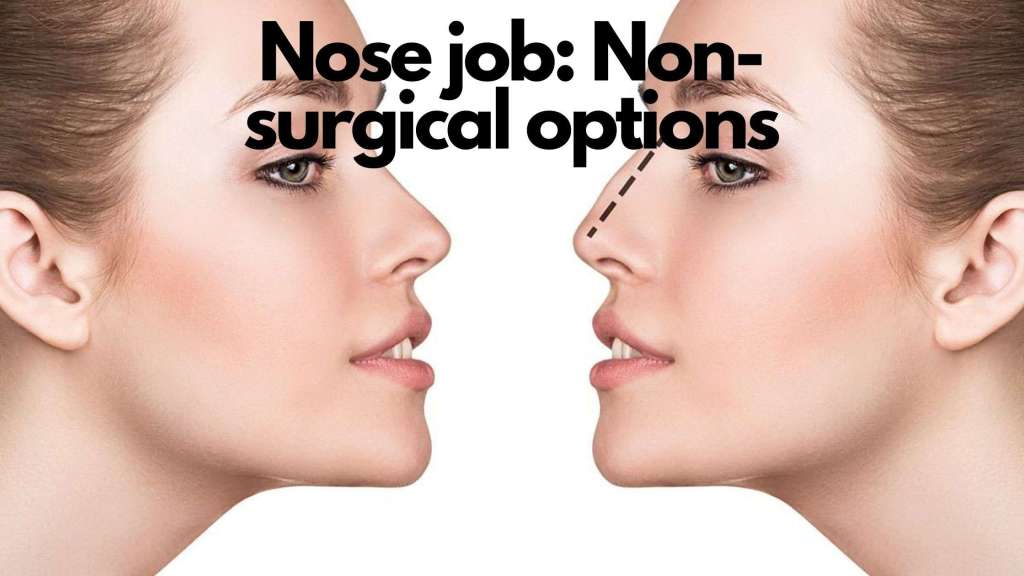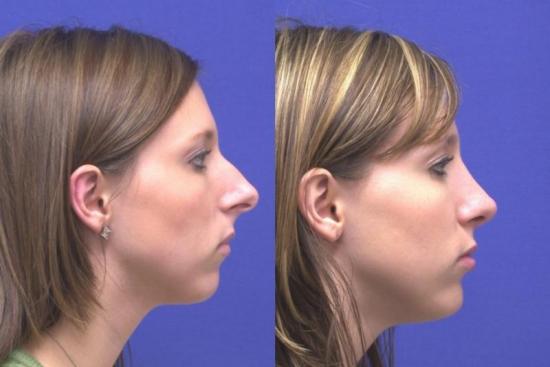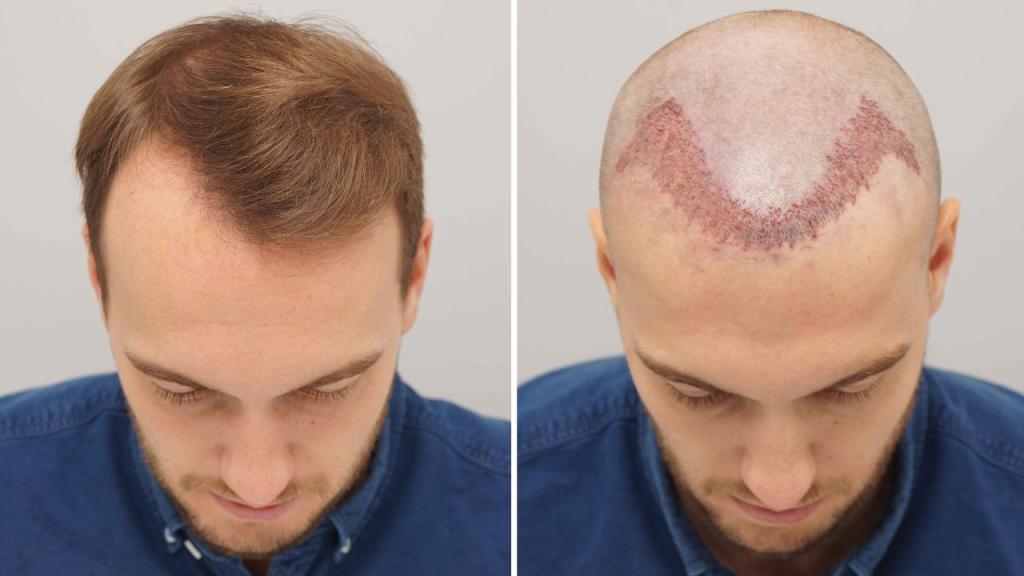Rhinoplasty: Surgical Nose Reshaping
Rhinoplasty, also known as surgical nose reshaping, is a popular cosmetic procedure that aims to enhance the appearance and function of the nose. It involves making incisions and manipulating the bone and cartilage to achieve the desired result. Rhinoplasty can address various concerns, such as a hump on the bridge of the nose, a crooked nose, a bulbous tip, or nostril asymmetry. This surgical procedure is performed under general anesthesia, and the recovery period can vary from a few weeks to several months depending on the individual.
On the other hand, non-surgical nose jobs offer a less invasive alternative to traditional rhinoplasty. This procedure involves the use of injectables and fillers to reshape and contour the nose. By strategically placing dermal fillers, skilled practitioners can correct minor imperfections and enhance the overall appearance of the nose. Non-surgical nose jobs are usually performed using local anesthesia, and the recovery time is significantly shorter compared to surgical rhinoplasty.
When deciding between rhinoplasty and a non-surgical nose job, several factors need to be considered. First and foremost, the level of correction required plays a crucial role. Non-surgical nose jobs are suitable for individuals looking to address minor aesthetic concerns, while surgical rhinoplasty is more appropriate for those seeking significant alterations to the nose’s structure and shape. Additionally, the cost comparison between the two options is also a vital consideration, as non-surgical nose jobs tend to be more affordable compared to surgical procedures.Comparing Recovery:
The recovery process for rhinoplasty and non-surgical nose jobs differs significantly. Following surgical rhinoplasty, patients typically experience swelling, bruising, and discomfort that may last for several weeks. It is essential to follow the post-operative instructions provided by the surgeon to promote healing and minimize complications. In contrast, non-surgical nose jobs have a relatively quicker recovery period, with minimal swelling and discomfort that usually subsides within a few days. This shorter downtime makes non-surgical options an attractive choice for individuals with busy lifestyles.
| Rhinoplasty | Non-Surgical Nose Job |
|---|---|
| Routine surgical procedure | Non-invasive procedure |
| Requires general anesthesia | Usually performed under local anesthesia |
| Longer recovery period | Shorter recovery period |
| Permanent results | Temporary results |
In conclusion, the decision between rhinoplasty and a non-surgical nose job depends on various factors, including the extent of correction needed, budgetary considerations, and recovery time. While rhinoplasty offers permanent results and can address complex nasal concerns, non-surgical options provide a less invasive and more affordable alternative for individuals seeking minor enhancements. Consulting with a qualified plastic surgeon or aesthetic practitioner is crucial to determine the right option based on individual goals, expectations, and overall health conditions.
Exploring Non-Surgical Nose Jobs: What To Expect
Non-surgical nose jobs, also known as non-surgical rhinoplasty or liquid rhinoplasty, are a popular alternative to traditional surgical rhinoplasty procedures. This minimally invasive cosmetic treatment involves the use of injectable fillers to reshape and enhance the appearance of the nose. But what exactly can you expect from a non-surgical nose job?
Firstly, it is important to note that a non-surgical nose job is not intended to address functional issues such as difficulty breathing or correcting serious deformities. Instead, it is primarily used to improve the shape, symmetry, and proportions of the nose for aesthetic purposes.
During the procedure, a qualified medical professional, typically a cosmetic surgeon or dermatologist, will carefully inject dermal fillers into specific areas of the nose. The type of filler used and the amount injected will depend on the individual’s unique needs and desired outcome.
| Benefits of Non-Surgical Nose Jobs: | Considerations of Non-Surgical Nose Jobs: |
|---|---|
| Non-invasive: Non-surgical nose jobs do not involve incisions or general anesthesia, resulting in minimal downtime and reduced risk of complications.Immediate results: Unlike surgical rhinoplasty, the results of a non-surgical nose job are typically visible immediately after the procedure.Temporary nature: The effects of dermal fillers used in non-surgical nose jobs are not permanent, allowing for adjustments or reversal if desired. | Limited correction: Non-surgical nose jobs can only address certain concerns, such as minor asymmetries, bumps, or depressions. They cannot reduce the overall size of the nose or correct structure-related issues.Duration of results: The effects of dermal fillers used in non-surgical nose jobs typically last from several months to a couple of years. Regular touch-ups are often required to maintain the desired outcome.Potential risks: While generally considered safe, non-surgical nose jobs carry their own set of risks, including potential infection, skin reactions, or vascular complications. |
In terms of recovery, non-surgical nose jobs generally involve minimal downtime. Some patients may experience minor swelling, redness, or bruising at the injection sites, but these side effects are usually temporary and can be easily concealed with makeup. It is recommended to avoid touching or applying pressure to the treated area for a few days after the procedure.
Before undergoing a non-surgical nose job, it is crucial to consult with a qualified specialist who can assess your specific needs and determine whether this procedure is suitable for you. They will discuss your expectations, explain the potential risks and limitations, and provide personalized advice on achieving the desired outcome.
Considering Rhinoplasty: Surgical Procedure Details
Rhinoplasty, also known as a surgical nose reshaping, is a cosmetic procedure that aims to enhance the appearance of the nose. It is a surgical procedure that involves making incisions in the nose to reshape its structure and form. The procedure can be performed for various reasons, including correcting a birth defect, improving breathing function, or enhancing facial harmony. Rhinoplasty is typically performed under general anesthesia, and the surgeon may use either an open or closed technique depending on the individual’s needs and goals.
During an open rhinoplasty procedure, the surgeon makes an incision on the columella, which is the thin strip of tissue between the nostrils. This approach allows for better visibility and access to the nasal structure, making it ideal for complex cases. On the other hand, in a closed rhinoplasty, all the incisions are made on the inside of the nose, leaving no visible scars. This technique is often used for minor cosmetic tweaks or functional adjustments.
Once the incisions are made, the surgeon will proceed to reshape the underlying bone and cartilage, which will ultimately determine the nose’s final appearance. This may involve removing excess tissue, reshaping the cartilage, or adding grafts to enhance the nasal structure. The surgeon will carefully sculpt and refine the nose to achieve the desired outcome while maintaining harmony with the patient’s facial features.
- The incisions are then closed with dissolvable sutures, and a splint or cast may be applied to provide support and protect the newly reshaped nose during the initial healing phase.
- Pain and discomfort following the rhinoplasty procedure are typically managed with prescribed medication. The recovery process can vary from person to person, but most individuals can expect some swelling, bruising, and congestion in the first week or two.
- It is crucial to follow the post-operative instructions provided by the surgeon to ensure proper healing and minimize the risk of complications. These instructions may include avoiding strenuous activities, refraining from blowing the nose, and keeping the head elevated during sleep.
| Advantages of Rhinoplasty | Disadvantages of Rhinoplasty |
|---|---|
| – Can achieve significant and long-lasting results | – Requires general anesthesia |
| – Allows for precise reshaping of the nose | – Longer recovery period compared to non-surgical options |
| – Can correct functional issues such as a deviated septum | – Risk of potential complications associated with surgery |
| – Provides permanent improvement in nasal appearance | – Higher cost compared to non-surgical alternatives |
Exploring Non-Surgical Options: Injectables And Fillers
When considering options for nose enhancement, many people automatically think of rhinoplasty, or surgical nose reshaping. However, there is another option that is less invasive and requires no surgery: injectables and fillers. This non-surgical approach to nose augmentation is becoming increasingly popular due to its minimal downtime and immediate results. In this blog post, we will explore the world of non-surgical options for nose enhancement, focusing specifically on injectables and fillers.
Injectables and fillers are cosmetic procedures that involve the use of dermal fillers to reshape and contour the nose. These fillers are typically made of hyaluronic acid, a substance that is naturally found in the body and provides hydration and volume. The procedure involves injecting small amounts of the filler into specific areas of the nose to achieve the desired shape and symmetry. Unlike surgical rhinoplasty, injectables and fillers provide temporary results, lasting anywhere from 9 months to 2 years. This makes it an ideal option for those who are not ready to commit to permanent changes.
One of the main advantages of injectables and fillers is the minimal downtime associated with the procedure. Unlike rhinoplasty, which requires weeks of recovery, non-surgical options allow patients to resume their normal activities almost immediately. There may be some minor swelling or bruising at the injection site, but this usually subsides within a few days. Additionally, injectables and fillers offer immediate results, allowing patients to see the outcome right after the procedure. This is in contrast to surgical rhinoplasty, where the final results may not be fully visible until several months have passed.
| Rhinoplasty | Non-Surgical Nose Job |
|---|---|
| Permanent results | Temporary results |
| Requires surgery | No surgery required |
| Longer recovery time | Minimal downtime |
| Full results take months to appear | Immediate results |
It is important to note that while injectables and fillers offer a less invasive alternative to surgical rhinoplasty, they may not be suitable for everyone. Individuals with severe nasal deformities or structural issues are generally better candidates for surgical intervention. Additionally, the cost of injectables and fillers can add up over time, as the effects are temporary and will require maintenance sessions. This is something to consider when deciding between surgical and non-surgical options for nose enhancement.
Comparing Recovery: Downtime And Healing Process
When considering any type of cosmetic procedure, it is important to understand the recovery process and the amount of downtime required. This is especially true when comparing two popular options for nose reshaping: rhinoplasty (surgical nose job) and non-surgical nose job using injectables and fillers. Understanding the differences in the recovery and healing processes can help you make an informed decision about which option is right for you.
Rhinoplasty:
Rhinoplasty is a surgical procedure that involves reshaping the nose to improve its appearance or enhance its function. The recovery period for rhinoplasty can vary depending on the complexity of the procedure and the individual’s healing ability. Generally, patients can expect some swelling and bruising around the nose and eyes for the first one to two weeks following surgery. Nasal stuffiness and mild discomfort are also common during the initial recovery period. The majority of swelling and bruising will subside within two to three weeks, although some residual swelling may persist for several months.
Non-Surgical Nose Job:
A non-surgical nose job, on the other hand, is a minimally invasive procedure that uses injectables and fillers to reshape and contour the nose. Unlike rhinoplasty, there is virtually no downtime associated with a non-surgical nose job. Patients can typically resume their normal activities immediately after the procedure. Some minor bruising or swelling at the injection sites may occur, but it generally subsides within a few days. The results of a non-surgical nose job are temporary and may last anywhere from several months to a year.
Comparison of Recovery and Healing Process:
When it comes to comparing the recovery and healing processes of rhinoplasty and non-surgical nose jobs, there are some key differences to consider. Rhinoplasty requires a longer recovery period, with potential downtime of up to two weeks or more. The swelling and bruising associated with rhinoplasty can take several weeks to completely resolve. In contrast, a non-surgical nose job offers minimal downtime, allowing patients to return to their daily activities almost immediately. The temporary nature of the results with a non-surgical nose job also means that any complications or dissatisfaction can be addressed or reversed more easily than with rhinoplasty.
Ultimately, the choice between rhinoplasty and non-surgical nose job depends on your individual goals, preferences, and willingness to undergo surgery. If you are looking for a permanent solution with more extensive changes to the nose, rhinoplasty may be the right choice for you. However, if you desire subtle changes and a quick recovery, a non-surgical nose job may provide the results you are seeking. Consulting with a qualified plastic surgeon or aesthetic practitioner can help you fully understand the recovery process for each option and make an informed decision.
Rhinoplasty Vs. Non-Surgical Nose Job: Cost Comparison
Rhinoplasty vs. Non-Surgical Nose Job: Which is Right for You?
When considering options for nose reshaping, it is important to compare the costs associated with both surgical rhinoplasty and non-surgical nose jobs. Rhinoplasty, also known as a surgical nose job, involves reshaping the nose through surgical procedures, while a non-surgical nose job typically involves the use of injectables and fillers to enhance the appearance of the nose. Both options have their advantages and disadvantages, but cost can be a significant factor in making a decision.
Rhinoplasty, as a surgical procedure, generally requires more intensive resources and expertise compared to a non-surgical nose job. The cost of a rhinoplasty can vary depending on factors such as the complexity of the surgery, the experience of the surgeon, and the location of the practice. On average, the cost of a rhinoplasty in the United States ranges from $5,000 to $10,000. It is important to note that this cost does not include potential additional expenses such as anesthesia, post-operative care, and follow-up appointments.
In contrast, a non-surgical nose job is often a more cost-effective option. The cost of a non-surgical nose job can range from $500 to $2,500, depending on the type and amount of fillers or injectables used. This lower cost can be attributed to several factors, including the lack of surgical fees, anesthesia fees, and hospital or facility costs. Additionally, non-surgical nose jobs typically require less downtime compared to rhinoplasty, which can also contribute to lower overall costs.
It is important to consider your specific goals and expectations when deciding between rhinoplasty and a non-surgical nose job. If you are looking for permanent and more significant changes to the size or shape of your nose, rhinoplasty may be the better option despite its higher cost. On the other hand, if you are seeking minor corrections or enhancements and prefer a less invasive procedure with quicker recovery time, a non-surgical nose job may be the right choice for you.
| Rhinoplasty | Non-Surgical Nose Job |
|---|---|
| Higher cost | Lower cost |
| Permanent results | Temporary results |
| More invasive | Less invasive |
| Longer recovery time | Shorter recovery time |
Consider your budget and available financial resources when comparing the cost of rhinoplasty and non-surgical nose jobs.Consult with a qualified plastic surgeon or dermatologist to discuss your options, budget, and expectations for nose reshaping.Remember that cost should not be the sole determining factor; it is important to prioritize your safety, satisfaction with the results, and overall well-being.
Choosing The Right Option: Factors To Consider
When it comes to enhancing the appearance of your nose, you have two main options: rhinoplasty and non-surgical nose job. Both procedures aim to achieve similar results, but they differ significantly in terms of technique, recovery, and cost. Before making a decision, it is important to consider various factors that will help you choose the right option for you.
Surgical Nose Reshaping: Rhinoplasty
Rhinoplasty, also known as a surgical nose job, is a cosmetic procedure that involves modifying the structure and shape of the nose through surgery. During the procedure, a surgeon makes small incisions to access the underlying nasal bones and cartilage. They can then reshape and resize the nose to achieve the desired aesthetic outcome. Rhinoplasty is a permanent solution and can address a wide range of concerns, including a crooked or humped nasal bridge, a bulbous tip, or a deviated septum that affects breathing. However, it is important to note that rhinoplasty requires a significant time commitment, as it involves a longer recovery period compared to non-surgical options and may result in some downtime.
Non-Surgical Nose Job: Injectables And Fillers
If you are looking for a non-invasive alternative to rhinoplasty, a non-surgical nose job may be a suitable option for you. This procedure involves the use of injectables, such as dermal fillers, to reshape and contour the nose. Fillers can be strategically injected to smooth out bumps, straighten the nasal bridge, or lift and refine the tip of the nose. One of the major advantages of a non-surgical nose job is that it requires minimal downtime and allows for immediate results. However, it is important to note that the effects of non-surgical procedures are temporary, lasting typically around 6 to 12 months. Regular touch-ups may be necessary to maintain the desired results.
Factors To Consider
When deciding between rhinoplasty and a non-surgical nose job, there are several factors you should consider. Firstly, it is important to have a clear understanding of your aesthetic goals. Rhinoplasty offers more extensive changes to the nose, making it a suitable option for individuals who desire significant reshaping. On the other hand, a non-surgical nose job is more suitable for those who wish to address minor imperfections or make subtle enhancements. Additionally, you should consider the amount of time you can allocate for the procedure and recovery. Rhinoplasty requires a longer recovery period and may involve more downtime compared to a non-surgical nose job. Lastly, cost is an important factor to consider. Generally, rhinoplasty is more expensive than a non-surgical nose job, so your budget may play a role in your decision-making process. Consulting with a qualified plastic surgeon or facial aesthetics specialist can provide you with the necessary information and guidance to make an informed decision.




Leave a comment